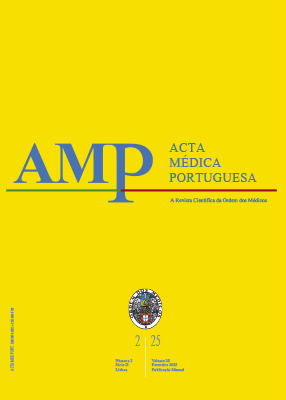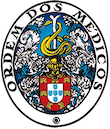Infeções do Trato Urinário em Pediatria: Evolução da Etiologia e Padrões de Resistências Locais ao Longo de Três Anos
DOI:
https://doi.org/10.20344/amp.21630Palavras-chave:
Criança, Infeções do Trato Urinário/etiologia, Infeções do Trato Urinário/microbiologia, Infeções do Trato Urinário/tratamento farmacológico, Resistência Bacteriana a MedicamentosResumo
Introdução: As infeções do trato urinário são comuns em idade pediátrica. Conhecer a etiologia e os padrões de resistência locais é fundamental na determinação do tratamento empírico. Propusemo-nos a rever os patógenos implicados nas infeções do trato urinário, os padrões de resistência locais e o impacto do ajuste da antibioterapia de primeira-linha de acordo com as mesmas.
Métodos: Conduzimos um estudo transversal que incluiu os doentes pediátricos que realizaram urocultura num hospital do Norte de Portugal durante dois períodos: 2019 (grupo 1) e 2022 (grupo 2). Entre estes dois períodos, foi instituído um protocolo interno de atuação clínica que recomendava a utilização de cefuroxima como antibioterapia empírica de primeira linha, de acordo com a epidemiologia local. Os grupos foram comparados quanto aos uropatógenos identificados, respetivos padrões de resistência a antimicrobianos e antibioterapia empírica instituída.
Resultados: Foram identificados 402 casos de infeções do trato urinário no grupo 1 e 398 no grupo 2. A Escherichia coli (E. coli) foi o uropatógeno mais comum (79,4% - 83,3%), seguido do Proteus mirabilis e da Klebsiella spp. No grupo 1, o antimicrobiano empírico mais frequentemente selecionado foi a amoxicillina-clavulanato (A-C), enquanto no grupo 2 foi a cefuroxima (p < 0.001). A resistência mais frequentemente identificada foi à ampicilina (39.3% - 39.7%). A resistência a A-C não mostrou alterações estatisticamente significativas entre grupos (33,1% vs 27,4%, p = 0,079), tal como a resistência à cefuroxima (4,7% vs 3,3%, p = 0,292) e ao trimetoprim-sulfametoxazol (TMP-SMX) (15,2% vs 14,1%, p = 0,659). As resistências à nitrofurantoína (9,0% vs 0,3%, p < 0.001) e à fosfomicina (1,7% vs 0,3%, p < 0,036) diminuíram significativamente entre o grupo 1 e o grupo 2.
Conclusão: A E.coli mantém-se como o principal agente de infeções do trato urinário em pediatria. A resistência a A-C na nossa amostra é elevada (33,1%). A alteração de antibioterapia empírica de primeira-linha de A-C para cefuroxima resultou numa tendência de diminuição da resistência à A-C, sem aumento da resistência a cefuroxima.
Downloads
Referências
Sobel JD. Pathogenesis of urinary tract infection. Role of host defenses. Infect Dis Clin North Am. 1997;11:531-49. DOI: https://doi.org/10.1016/S0891-5520(05)70372-X
Spencer JD, Schwaderer A, McHugh K, Hains DS. Pediatric urinary tract infections: an analysis of hospitalizations, charges, and costs in the USA. Pediatr Nephrol. 2010;25:2469-75. DOI: https://doi.org/10.1007/s00467-010-1625-8
Leung AK, Wong AH, Leung AA, Hon KL. Urinary tract infection in children. Recent Pat Inflamm Allergy Drug Discov. 2019;13:2-18. DOI: https://doi.org/10.2174/1872213X13666181228154940
Morello W, La Scola C, Alberici I, Montini G. Acute pyelonephritis in children. Pediatr Nephrol. 2016;31:1253-65. DOI: https://doi.org/10.1007/s00467-015-3168-5
Shaikh N, Morone NE, Bost JE, Farrell MH. Prevalence of urinary tract infection in childhood: a meta-analysis. Pediatr Infect Dis J. 2008;27:302-8. DOI: https://doi.org/10.1097/INF.0b013e31815e4122
Brandström P, Hansson S. Urinary tract infection in children. Pediatr Clin North Am. 2022;69:1099-114. DOI: https://doi.org/10.1016/j.pcl.2022.07.003
Vazouras K, Velali K, Tassiou I, Anastasiou-Katsiardani A, Athanasopoulou K, Barbouni A, et al. Antibiotic treatment and antimicrobial resistance in children with urinary tract infections. J Glob Antimicrob Resist. 2020;20:4-10. DOI: https://doi.org/10.1016/j.jgar.2019.06.016
Demir M, Kazanasmaz H. Uropathogens and antibiotic resistance in the community and hospital-induced urinary tract infected children. J Glob Antimicrob Resist. 2020;20:68-73. DOI: https://doi.org/10.1016/j.jgar.2019.07.019
Rosado MR, Molina AG, Velasco AL, Chinchilla GC, Lana PV, Izquierdo EO, et al. Urinary tract infection in pediatrics: study of uropathogens and their resistance in a Madrid hospital. Arch Esp Urol. 2022;75:791-7. DOI: https://doi.org/10.56434/j.arch.esp.urol.20227509.115
Schlager TA. Urinary tract infections in children younger than 5 years of age: epidemiology, diagnosis, treatment, outcomes and prevention. Paediatr Drugs. 2001;3:219-27. DOI: https://doi.org/10.2165/00128072-200103030-00004
Miron D, Grossman Z. The diagnosis and therapy of first community acquired urinary tract infection in children. Harefuah. 2009;148:778-82, 791, 792.
Oh MM, Kim JW, Park MG, Kim JJ, Yoo KH, Moon du G. The impact of therapeutic delay time on acute scintigraphic lesion and ultimate scar formation in children with first febrile UTI. Eur J Pediatr. 2012;171:565- 70. DOI: https://doi.org/10.1007/s00431-011-1614-3
A’t Hoen L, Bogaert G, Radmayr C, Dogan HS, Nijman RJ, Quaedackers J, et al. Update of the EAU/ESPU guidelines on urinary tract infections in children. J Pediatr Urol. 2021;17:200-7. DOI: https://doi.org/10.1016/j.jpurol.2021.01.037
Erol B, Culpan M, Caskurlu H, Sari U, Cag Y, Vahaboglu H, et al. Changes in antimicrobial resistance and demographics of UTIs in pediatric patients in a single institution over a 6-year period. J Pediatr Urol. 2018;14:176.e1-5. DOI: https://doi.org/10.1016/j.jpurol.2017.12.002
Buettcher M, Trueck J, Niederer-Loher A, Heininger U, Agyeman P, Asner S, et al. Swiss consensus recommendations on urinary tract infections in children. Eur J Pediatr. 2021;180:663-74. DOI: https://doi.org/10.1007/s00431-020-03714-4
Direção-Geral da Saúde. Norma da Direção-Geral da Saúde 008/2012 de 16/12/2012. Diagnóstico e tratamento da infeção do trato urinário em idade pediátrica. [cited 2023 Aug 17]. Available from: https://www.spp. pt/UserFiles/file/Seccao_Nefrologia/Norma%20de%20Orientacao%20 Clinca_ITU.pdf.
Cag Y, Haciseyitoglu D, Ozdemir AA, Cag Y. Antibiotic resistance and bacteria in urinary tract infections in pediatric patients. Medeni Med J. 2021;36:217-24.
Choi UY, Han SB, Lee SY, Kang JH, Kim SM, Ma SH. Regional differences in phylogenetic group of Escherichia coli strains isolated from children with urinary tract infection in Korea. Korean J Pediatr. 2012;55:420-3. DOI: https://doi.org/10.3345/kjp.2012.55.11.420
Mattoo TK, Shaikh N, Nelson CP. Contemporary management of urinary tract infection in children. Pediatrics. 2021;147:e2020012138. DOI: https://doi.org/10.1542/peds.2020-012138
Diviney J, Jaswon MS. Urine collection methods and dipstick testing in non-toilet-trained children. Pediatr Nephrol. 2021;36:1697-708. DOI: https://doi.org/10.1007/s00467-020-04742-w
Alberici I, Bayazit AK, Drozdz D, Emre S, Fischbach M, Harambat J, et al. ESCAPE Study Group; PREDICT Trial. Pathogens causing urinary tract infections in infants: a European overview by the ESCAPE study group. Eur J Pediatr. 2015;174:783-90. DOI: https://doi.org/10.1007/s00431-014-2459-3
Ipek IO, Bozaykut A, Arman DC, Sezer RG. Antimicrobial resistance patterns of uropathogens among children in Istanbul, Turkey. Southeast Asian J Trop Med Public Health. 2011;42:355-62.
Choi U, Kim E, Lyu DH, Kim KS, Park BH, Chung H, et al. The change of antibiotic susceptibility in febrile urinary tract infection in childhood and adolescence during the last decade. Investig Clin Urol. 2022;63:99-106. DOI: https://doi.org/10.4111/icu.20210350
Joya M, Aalemi AK, Baryali AT. Prevalence and antibiotic susceptibility of the common bacterial uropathogen among UTI patients in french medical institute for children. Infect Drug Resist. 2022;15:4291-7. DOI: https://doi.org/10.2147/IDR.S353818
Shaki D, Hodik G, Elamour S, Nassar R, Kristal E, Leibovitz R, et al. Urinary tract infections in children < 2 years of age hospitalized in a tertiary medical center in Southern Israel: epidemiologic, imaging, and microbiologic characteristics of first episode in life. Eur J Clin Microbiol Infect Dis. 2020;39:955-63. DOI: https://doi.org/10.1007/s10096-019-03810-w
Brito H, Gonzaga D, Pereira P, Rocha L, Matos P. Infeção do trato urinário: agentes etiológicos e padrão de resistência local. Nascer e Crescer. 2012;21:222-5.
Khan A, Jhaveri R, Seed PC, Arshad M. Update on associated risk factors, diagnosis, and management of recurrent urinary tract infections in children. J Pediatric Infect Dis Soc. 2019;8:152-9. DOI: https://doi.org/10.1093/jpids/piy065
Parry CM, Taylor A, Williams R, Lally H, Corbett HJ. Antimicrobial resistance of breakthrough urinary tract infections in young children receiving continual antibiotic prophylaxis. Eur J Pediatr. 2023;182:4087- 93. DOI: https://doi.org/10.1007/s00431-023-05087-w
Craig JC, Simpson JM, Williams GJ, Lowe A, Reynolds GJ, McTaggart SJ, et al. Prevention of recurrent urinary tract infection in children with vesicoureteric reflux and normal renal tracts (PRIVENT) investigators. Antibiotic prophylaxis and recurrent urinary tract infection in children. N Engl J Med. 2009;361:1748-59. DOI: https://doi.org/10.1056/NEJMoa0902295
Downloads
Publicado
Como Citar
Edição
Secção
Licença
Direitos de Autor (c) 2025 Acta Médica Portuguesa

Este trabalho encontra-se publicado com a Creative Commons Atribuição-NãoComercial 4.0.
Todos os artigos publicados na AMP são de acesso aberto e cumprem os requisitos das agências de financiamento ou instituições académicas. Relativamente à utilização por terceiros a AMP rege-se pelos termos da licença Creative Commons ‘Atribuição – Uso Não-Comercial – (CC-BY-NC)’.
É da responsabilidade do autor obter permissão para reproduzir figuras, tabelas, etc., de outras publicações. Após a aceitação de um artigo, os autores serão convidados a preencher uma “Declaração de Responsabilidade Autoral e Partilha de Direitos de Autor “(http://www.actamedicaportuguesa.com/info/AMP-NormasPublicacao.pdf) e a “Declaração de Potenciais Conflitos de Interesse” (http://www.icmje.org/conflicts-of-interest) do ICMJE. Será enviado um e-mail ao autor correspondente, confirmando a receção do manuscrito.
Após a publicação, os autores ficam autorizados a disponibilizar os seus artigos em repositórios das suas instituições de origem, desde que mencionem sempre onde foram publicados e de acordo com a licença Creative Commons









